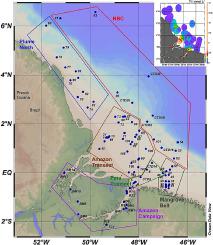Marine Chemistry ( IF 3.0 ) Pub Date : 2021-12-13 , DOI: 10.1016/j.marchem.2021.104067 Alexandre B. Schneider 1 , Andrea Koschinsky 2 , Cristian H. Krause 1 , Martha Gledhill 3 , Leandro M. de Carvalho 4

|
Ultratrace concentrations of Ti were determined by catalytic differential pulse adsorptive stripping voltammetry (cDPAdSV) in samples collected in the Pará and Amazon estuaries and plume into the Atlantic Ocean. Different end members including rivers Tocantins, Amazon and Pará and Atlantic seawater were sampled as well as the salinity gradients in the mixing zone between the river outflows and waters from the North Brazil Current during several transects. The Mangrove Belt southeast of the Pará river mouth with its extensive groundwater discharge was also sampled. Most samples were taking during cruise M147 (GEOTRACES process study GApr11) during the high discharge period in April and May 2018. In addition to high resolution determination of dissolved Ti distributions in this region, size fractionation was investigated by using several filtration steps with pore sizes (0.2 μm, and 0.015 μm) and ultrafiltration (10 kDa and 1 kDa) at four selected stations. Dissolved Ti varied significantly between different river end members and showed a non-conservative behavior along the mixing gradients with strong removal at low salinities and some enrichments at higher salinity ranges. The results suggest that there was both adsorption and desorption of Ti from suspended particles from both riverine and marine sources or flocculation and aggregation of colloids and particulate matter from end member rivers as well as resuspension at particular salinity ranges. The 0.015 μm filtered and 10 kDa and 1 kDa ultrafiltered aliquots showed variable distributions of Ti in the different size fractions, depending on the sampling zone. This very complex behavior of Ti along the mixing gradient and the dynamic system of the Amazon estuary, which comprises a fifth of the global freshwater flux into the ocean, is the key to controlling the fluxes of Ti into the Atlantic.
中文翻译:

沿帕拉和亚马逊河口系统及相关羽流盐度梯度溶解和可溶钛的动态行为
Ti 的超痕量浓度是通过催化微分脉冲吸附溶出伏安法(cDPAdSV) 在 Pará 和亚马逊河口以及流入大西洋的羽流中收集的样品中测定的。不同的终端成员,包括河流托坎廷斯、亚马逊河和帕拉河以及大西洋海水在几个横断面期间,对河流流出和来自巴西北部海流的水之间的混合带中的盐度梯度进行了采样。帕拉河口东南部的红树林带及其广泛的地下水排放也进行了采样。大多数样品是在 2018 年 4 月和 2018 年 5 月的高排放期在巡航 M147(GEOTRACES 工艺研究 GApr11)期间采集的。除了该区域溶解钛分布的高分辨率测定外,还通过使用具有孔径的几个过滤步骤来研究尺寸分馏(0.2 μm 和 0.015 μm)和超滤(10 kDa 和 1 kDa)在四个选定的站点。不同河端成员之间溶解的 Ti 变化显着,并且沿着混合梯度显示出非保守行为,在低盐度下强烈去除,在较高盐度范围内富集。结果表明,Ti从河流和海洋来源的悬浮颗粒中吸附和解吸或来自末端成员河流的胶体和颗粒物的絮凝和聚集以及在特定盐度范围内重新悬浮。0.015 μm 过滤和 10 kDa 和 1 kDa 超滤等分试样在不同尺寸部分显示出不同的 Ti 分布,这取决于采样区。Ti 沿着混合梯度的这种非常复杂的行为和亚马逊河口的动态系统(占全球流入海洋的淡水通量的五分之一)是控制 Ti 流入大西洋的关键。










































 京公网安备 11010802027423号
京公网安备 11010802027423号